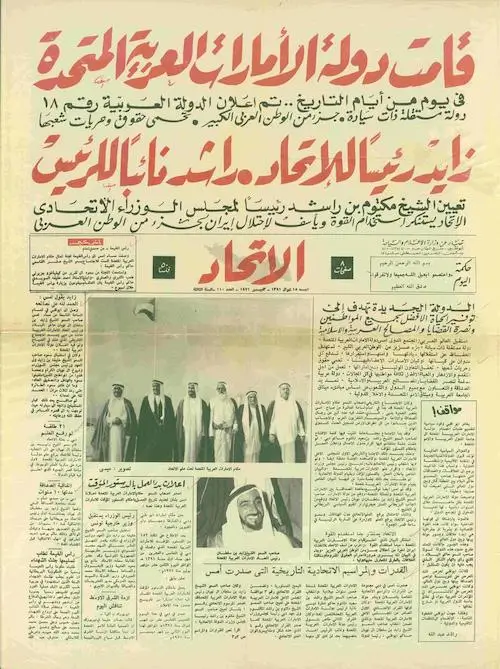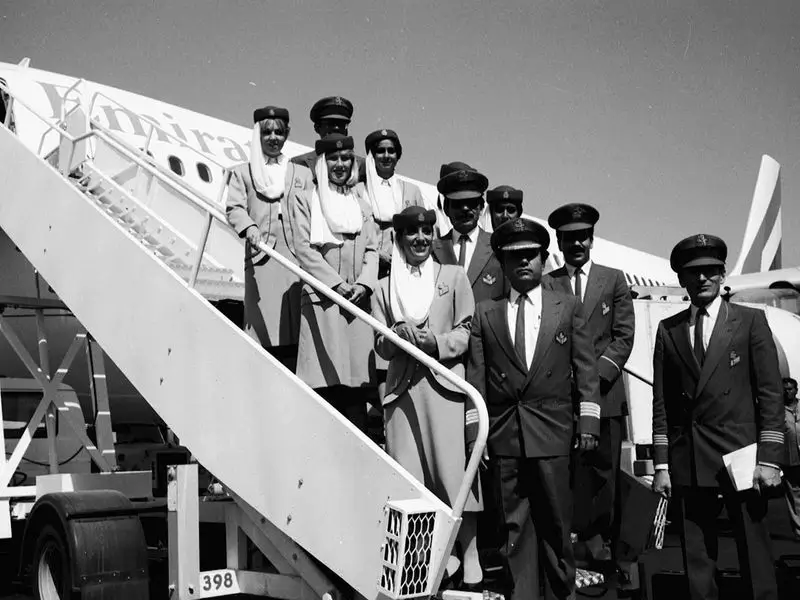1966 - Modern Day: The rapid development of modern Dubai
1966-1971: Formation and Independence of the UAE
More oil fields were discovered after the first one in Fateh: southwest Fateh in 1970, and both Rashid and Faleh in 1976. Although Abu Dhabi was more prosperous in their oil findings - with Dubai only having one-twentieth of what Abu Dhabi had - Dubai still managed to use the money from the oil to fund several projects for the Gulf, building and creating the modern day landscape we have come to know.
Up until this point, Dubai and the other Trucial States were still British protectorates. But it started to become too expensive to keep British troops abroad in Dubai due to the devaluation of the pound. Harold Wilson, prime minister of the United Kingdom between 1964-1970, announced that Britain would therefore withdraw all its armed forces from the Gulf. Roy Jenkins, who served as Chancellor of the Exchequer between 1967 and 1970, put forward a proposal that stated Britain would withdraw its armed forces by 1st April 1971. With no British ruling of the Trucial States, this would start the formation of the United Arab Emirates.

After several years of war with each other, Sheikh Zayed (ruler of Abu Dhabi) and Sheikh Rashid (ruler of Dubai) made a truce to come together to start the formation of the United Arab Emirates. Meetings of the then 9 nations to form the UAE (including Bahrain and Kuwait, who would later choose independence) began in Dubai, known as the Dubai Meeting. As Abu Dhabi then generated 80% of the Trucial States’ income, it was clear that Sheikh Zayed would become president of the federation, making Abu Dhabi the capital of the UAE. This would, in turn, confirm Sheikh Zayed’s leadership.
Several meetings later, on 18th July 1971, Sheikh Zayed officially announced the formation of the United Arab Emirates, which then comprised 6 of the 7 Trucial States - Ras al Khaimah later joined on 10th February 1972 - forming the 7 emirates. On 1st December 1971, the existing treaties between the Trucial States and Great Britain were revoked, ending Great Britain's ruling. The next day, on 2nd December 1971, the (then six) rulers signed the provisional constitution and elected Sheikh Zayed as president of the UAE, and Sheikh Rashid vice president. The United Arab Emirates had finally gained their independence, celebrated every year on the 2nd December as National day (Al Yawm Al Watani in Arabic). 2021 saw the United Arab Emirates celebrate its 50th year of independence.
1971 - Today: The evolution of Dubai
The discovery of oil led to the investment in the construction of public infrastructure in Dubai. Roads were built, schools and hospitals. Sheikh Zayed Road (E11) was proposed to Sheikh Zayed, and in 1971 the project was approved and construction began. Sheikh Zayed road was finished in 1980, and serves as the longest motorway in the UAE, serving as a link between Abu Dhabi and Dubai. Long gone are the days of battling over borders.
Knowing that the oil reserves were limited, Sheikh Rashid of Dubai began to invest in the development of Dubai’s economy and tourism. In 1985, the Emirates airline was established to help further reinvent Dubai as a tourist hub. Since then, several projects have been built and completed, further marking Dubai on the map as the destination to go to.

After the death of Sheikh Rashid in 2006, Sheikh Mohammed bin Rashid Al Maktoum (shorthand: Sheikh Maktoum) became the new ruler of Dubai and vice president of the UAE. Sheikh Maktoum had been planning for the day that Dubai ran out of oil, promoting Dubai as a financial and trading hub for the Middle East. The Al Maktoum philosophy of “build and they will come”, first started with the late Sheikh Rashid, was carried forward by Sheikh Maktoum and his older brother, Sheikh Mohammed. Sheikh Mohammed continued this rapid building and expansion of Dubai, with his reign seeing a campaign in global investment.
In 1999, the Burj al Arab hotel was established, becoming the tallest hotel and only 7-star hotel in the world. In 2008, the Atlantis hotel, The Palm hotel and The Resort> launched, followed by the opening of Dubai Mall in 2009, still the world’s largest mall to date. In 2010, the Burj Khalifa was opened, becoming the world’s tallest building. In 2013, Dubai won the bid to host the World Expo 2020, building what is now known as Dubai Expo City solely for the purpose of hosting the Expo. Although delayed due to the pandemic, the Expo was pushed back and held between 1st October 2021 and 31st March 2022. Just recently, Dubai Expo City hosted COP 28 between Thursday 30th November and Wednesday 13th December 2023. It all goes to show that Dubai knows no limits in setting itself on the map for the world to see.